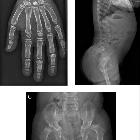atlanto-axial subluxation











Atlanto-axial subluxation is a disorder of C1-C2 causing impairment in rotation of the neck. The anterior facet of C1 is fixed on the facet of C2. It may be associated with dislocation of the lateral mass of C1 on C2.
Pathology
Etiology
- congenital
- arthritides
- acquired
- trauma
- retropharyngeal abscess / Grisel syndrome
- surgery
- upper respiratory tract infection
Mechanism
There are several ways in which a subluxation can occur:
- anteroposterior subluxation
- rotatory subluxation, known as atlantoaxial rotatory fixation (AARF) is characterized into four different types :
- type I: the atlas is rotated on the odontoid with no anterior displacement
- type II: the atlas is rotated on one lateral articular process with 3 to 5 mm of anterior displacement
- type III: comprises a rotation of the atlas on both lateral articular processes with anterior displacement greater than 5 mm
- type IV: characterized by rotation and posterior displacement of the atlas
- vertical subluxation
- lateral subluxation
Radiographic features
Plain radiograph
In a non-traumatic setting flexion and extension views may be performed. The expected distance between anterior arch of C1 and the dens in the fully flexed position should be <3 mm in an adult (~5 mm in a child).
In a vertical subluxation, the dens is often above the McGregor line by over 8 mm in men and 9.7 mm in women.
CT
On CT, C1 is not oriented in line with the head. The head may be pointed anteriorly, C1 is turned. If this is a fixed defect, C2 is rotated in conjunction with C1.
Differential diagnosis
Possible differential considerations on imaging include:
Siehe auch:

 Assoziationen und Differentialdiagnosen zu atlantoaxiale Subluxation:
Assoziationen und Differentialdiagnosen zu atlantoaxiale Subluxation:




